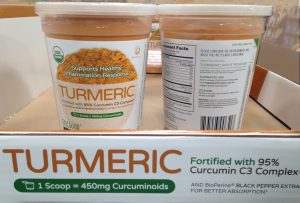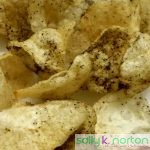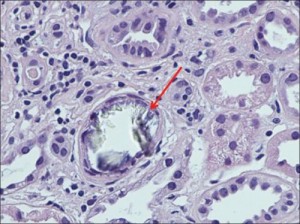Spice of Life: about Spices and Oxalate content
Eventually, you’ll get around to wondering: which spices are high in oxalate? You wouldn’t imagine they could make a big difference, those light sprinklings of everyday seasonings. But they do.
A quarter teaspoon of regular old black pepper has as much oxalate as 1.5 cups of sliced onions and 22 times as much as the same amount of white pepper. In fact, if you’re sticking to an intake of 50 mg of oxalate every day, that ¼ teaspoon of pepper would occupy 6% of your days’ total oxalate allowance.
Granted, we need to take care of the heavy hitters first. After all, the 3 mg of oxalate in a ¼ tsp. of black pepper pales in comparison to the 33 mg provided by a 3-ounce portion of french fries or the 150 mg in one fluffy, half-ounce cup of raw spinach. Given the heavy hit made by these modern lunch foods, we’re tempted to discard any concern over how our food is seasoned.
But that would be a mistake.
Helen’s Breakthrough
My friend Helen is a case in point. She was still in chronic pain due to an auto accident 13 years ago. And she was also trying to drop stubborn pounds after decades of frustration at not losing weight while enduring a constant nagging hunger. For years she had struggled to get control of her tendency to reach for chips, soda pop, and a quick sandwich. Thus, she was pleased with her recent success in sticking with a strict no-sugar, no-gluten diet, but feeling discouraged that the excess pounds didn’t drop, not in the least.
Her best efforts to follow the combined advice of her nutritionist and counselor led to other frustrations too. Some of their advice conflicted with what her body was telling her—that many vegetables didn’t agree with her. “Healthy” foods often gave her stomach pains. Her nutritionist and counselor both insisted that she just needed to comply and eat her vegetables. She was caught in a tussle and needing some new ideas. I ran into Helen in a local café and she begged for my input. She needed more options, desperate for a breakthrough.
Trying Low-Oxalate
As we chatted, I told her that my physical energy and mental focus was much better on the low-oxalate diet—simply by avoiding certain vegetables, nuts, and fruits. In no way was I suggesting that this was a fit for her situation. But Helen insisted that I look at her diet and suggest changes. She wanted to know what not to eat. On a napkin, I wrote a list of low-oxalate vegetables she could have and told her to eat more butter and olive oil. I never mentioned spices. Later she set an appointment to get more details and suggestions, so she could try this approach and still comply with her counselor’s advice to eat “healthy foods”.
A few weeks passed, it was mid-July, and a much happier Helen called me. “I feel like I got my life back. I know this sounds like a trite exaggeration, but this approach has worked miracles” she said. “I feel better and I am not getting headaches. I’ve stopped taking Advil at night. My stomach aches are better, and my digestion is finally working. For once, I feel as if I am digesting and absorbing my food and I don’t feel hungry. I am eating much less, and it is easy. I am feeling a level of peace and simplicity about it like never before.”
Many Spices are High in Oxalate!
Helen got a second breakthrough when she studied my table of oxalate in foods. She was amazed to learn how much oxalate was packed into black pepper, cumin, turmeric, and other spices.
She had always gravitated to spicy foods. Her favorite snack, specially ordered and shipped in, was black pepper potato chips. Her favorite local hot-bar was stocked with heavily seasoned foods loaded with exotic aromas and strong, pungent spices, including: Indian curries, Ethiopian cuisine, and Mexican-style dishes.
After seeing the actual numbers, the amount of oxalate conveyed to her diet by seasonings, she made a big, surprising shift. She started cooking most all her meals at home… cooking for one and eating alone, just she and her cats. She does NOT like to cook, and keeps it all as simple as she can. She tells me: This produced another breakthrough. Her back and knee pain were so much better! She could walk, exercise, and take stairs like she hasn’t for years.
Refine Your Diet
Paying more attention to spices might be a good way to refine your oxalate-aware eating plan. If you are really already avoiding potato chips, fries, nuts, snacks with nuts and seeds, spinach, and so on – the spice cabinet might be your next step. After all, most spices are potent seeds.
If you love spice too or love to cook with spices like I do, you might be daunted or otherwise resist this step. (It took me years to discard several spices languishing in my cabinet.) Please, don’t be afraid of cleaning out your spice cabinet. You can still enjoy great food, even with a simplified approach to seasoning. Undoubtedly, the best flavors come from the quality of the ingredients. When handled with care and skill in the kitchen, fresh ingredients shine without excessive embellishment. But, you don’t have to give up spices entirely – just be aware of what you’re eating, and use spices that are consistent with your low-oxalate goals.
Alternatives to High Oxalate Seasoning
Easy Substitutions and Approaches to Bringing out the Flavor of Foods
1. White pepper in place of black pepper
2. Lower the amounts of spices in your cooking by half
3. Use more white pepper, ground mustard seed, pinches of cayenne pepper, and mineral-type salts like pink Himalayan or Real Salt brand salt (ancient sea salt mined in Utah).
4. Use more salt. If you’re not eating processed food, you’re getting half of what most people are. And salt has an undeservedly bad nutritional reputation in any case: you might even need more salt to be healthy!
5. Add a hint of lemon juice, lime juice, or vinegar just before serving to give all the flavors in your dish a subtle lift.
6. Use enough fat when cooking and serving. An extra dash of olive oil or butter when garnishing and serving extends and enhances flavors.
7. Try prepared horseradish more often. It is great with beef and seafood. Good stirred into sour cream or yogurt, too (along with Frank’s Hot Sauce).
Essential oils and extracts can make good substitutes in the kitchen. Begin with these easy substitutions:
1. To replace (whole root) turmeric use a turmeric extract sold as a dietary supplement. (Start with 1 -3 caps per recipe, opened and the capsule discarded.) (Oxalate tends to stick to fibers and other elements removed when an extract is made.)
2. To replace lemon peel: use oil of lemon (1 small drop per tsp. of zest) or lemon extract (1/4 tsp./ lemon). (Oxalate is filtered out during extraction, and does not hang around in the oil fraction of any given food.)
Extracts typically don’t have exactly the same taste as the whole spice, but for certain recipes they can still provide a safe and pleasant flavor enhancement.
An adventurous cook will want to try using other essential oils too…
. . . such as the essential oils of clove, ginger, cardamon, and cumin seed oil (not black cumin seed -nigella- oil – which has very little flavor) (Cumin seed oil is hard to find.)
- Purchase high-quality edible grade essential oils and a brown glass dropper bottle.
- Dilute the essential oil 10:1 (5 teaspoons macadamia or almond oil to 1/2 teaspoon essential oil).
- Label the brown glass dropper bottle with the names of the two oils used and the ratio of your mixture. (invest in a quality label machine). Store the mixture in a dark cabinet.
- When cooking, add the oil at the last step of preparation.
- Use only one drop of the diluted oil per recipe, taste and adjust up from there.
- Make notes about what worked or didn’t.
For Curry Style Foods . . .
Try the curry styles of Thailand. Instead of cumin and turmeric (Indian style curry ingredients), Thai food are seasoned with various combinations of the following: cayenne, chili peppers, garlic, lime, lemongrass, mint, coconut milk, fish sauce, onion, and cilantro. To make the switch, keep these four ingredients on hand: 1) Thai chili paste (red or green), 2) fish sauce, 3) limes, and 4) coconut milk or coconut milk powder. Use the first 3 in ~1 tablespoon amounts… you can make nearly any dish interesting. These four ingredients can easily transform bone broth into something really nice.
Oxalate in Spices
High Oxalate SpicesMilligrams (mg) of oxalate (culinary portions)
|
Moderate Oxalate SpicesMilligrams (mg) of oxalate (culinary portions)
|
Oh, Spice Road: Spices in Verse
Pepper black, pepper red,
pepper, pepper
excite me, entertain me,
soothe me.
Conceal, mask, camouflage.
Spice, satisfy me, soothe me.
What longings, what emptiness shall I fill?
What hunger, what boredom, what lack can you displace?
Hunger, hunger what do you want?
Let me run away, travel, find jungle, beach, tropical paradise.
Oh, spice road, take me away from here.
What can you show me? What can you mask?
What fears can you quell? Sadness, aloneness, weakness, death?
Oh, spice entertain me! Oh, spice connect me, me oh spice, warm me, rev me, jolt me alive.
Oh, spice don’t flog me, punish me, or make me fat.
Hunger, hunger what do you want?



